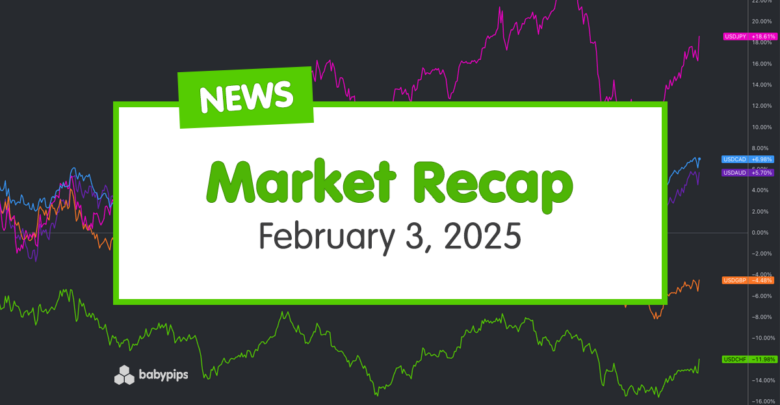Tariff fears and headlines dominated price action on Monday, as traders looked for updates over a potential trade war.
Gold was as big a winner as Kendrick Lamar in the Grammys, as it hit fresh record highs amid the uncertainty. Meanwhile, bitcoin and U.S. stocks recovered from their lows while crude oil prices and the U.S. dollar traded lower.
Here’s how your closely-watched assets moved in the first trading day of February:
Headlines:
- China Caixin manufacturing PMI for January: 50.1 (50.6 forecast, 50.5 previous)
- Procure Switzerland manufacturing PMI for January: 47.5 (49.0 forecast, 48.4 previous)
- HCOB Eurozone final manufacturing PMI revised higher from 46.1 to 46.6 in January
- S&P Global U.K. final manufacturing PMI revised higher from 48.2 to 48.3 in January
- S&P Global Canada manufacturing PMI for January: 51.6 (52.2 previous); Output price inflation rose by its highest since August; There was a “modest increase” in staffing levels
- S&P Global U.S. final manufacturing PMI revised higher from 50.1 to 51.2 in January; The pace of job creation was the highest since June 2024; Factory gate price inflation rose to its fastest since March 2024
- U.S. ISM manufacturing PMI resumed expansion in January
- FOMC members hinted at a more gradual approach to rate cuts:
- FOMC member Raphael Bostic said he’d be “very satisfied to wait for a while” before making more policy changes
- FOMC member Susan Collins said “there’s no urgency for making additional adjustments” given the tariff uncertainty
- FOMC member Austan Goolsbee said they’ve now got to be “a little more careful and more prudent” on cutting interest rates amid tariff impact
- OPEC+ agreed to stick to its plans of raising output from April
- Trump agrees to pause tariffs on Canada and Mexico after they pledge to boost border enforcement
Broad Market Price Action:
Dollar Index, Gold, S&P 500, Oil, U.S. 10-yr Yield, Bitcoin Overlay Chart by TradingView
The major assets were all over the place after Trump’s weekend tariff announcements, but trade fears calmed down when he decided to delay Mexican tariffs by a month. The initial shock from slapping 25% tariffs on Canada and Mexico and 10% on China sparked broad risk-off moves, but the panic eased as the U.S. session went on.
Oil prices felt the heat—WTI crude hovered jumped to $74.40 early on, then took a nosedive well before the U.S. market opened. The selloff picked up speed after OPEC+ and friends stuck to their plans to boost oil production starting in April, dragging prices down about 2% as traders also braced for weaker demand from a potential trade war.
Bitcoin staged an epic comeback after an early drop to $91,550, bouncing back above $100,000 as crypto traders jumped in to buy the dip. Safe haven gold hit a fresh record high at $2,833.90, even with risk sentiment improving later in the day.
Treasury yields acted a bit counterintuitive—despite tariffs usually stoking inflation fears, the 10-year yield dipped to 4.46% in a safety rush before settling at 4.54%. Global stocks clawed back from their worst losses but still closed lower, with tech names taking a hit thanks to trade jitters and last week’s DeepSeek AI announcement.
FX Market Behavior: U.S. Dollar vs. Majors:

Overlay of USD vs. Major Currencies Chart by TradingView
The U.S. dollar surged in Asian trading after Trump’s weekend tariff announcements sparked a flight to safety, especially against commodity currencies. But the greenback started to lose steam during the late Asian and early European sessions.
The dollar’s slide picked up pace after news broke that Trump would delay tariffs on Mexico for a month following a border security deal. The U.S. session open brought more pressure, with the dollar falling further even though U.S. manufacturing PMI came in stronger than expected at 50.9 vs. the 49.8 forecast. Fresh selling kicked in when Canada also secured a 30-day delay on tariffs.
Notable moves included USD/CAD hitting a 22-year high of 1.4973 before pulling back sharply to 1.4655 after the Canadian tariff delay. EUR/USD rebounded from 1.0212 to 1.0275, while GBP/USD jumped from 1.2249 to 1.2345 as trade tensions eased.
Upcoming Potential Catalysts on the Economic Calendar:
- France government budget balance at 7:45 am GMT
- Spain unemployment change at 8:00 am GMT
- U.S. JOLTS job openings at 3:00 pm GMT
- U.S. factory orders at 3:00 pm GMT
- U.S. FOMC member Bostic to give a speech at 4:00 pm GMT
- U.S. FOMC member Daly to give a speech at 7:00 pm GMT
- New Zealand labor market numbers at 9:45 pm GMT
- Japan average cash earnings at 11:30 pm GMT
European traders may see modest moves from Spain’s unemployment and the French budget balance, but volatility will likely pick up during the U.S. session with JOLTS job openings, factory orders, and remarks from Bostic and Daly, which could influence USD if they hint at shifts in Fed policy.
There’s also a chance that trade or tariff-related updates could sway risk sentiment throughout the day so make sure you stay glued to the tube for any market-moving headlines!
Don’t forget to check out our brand new Forex Correlation Calculator when taking any trades!


